Hurricanes and Climate Change: Unpredictable Paths and Increased Risks

The article discusses the unusual trajectories of hurricanes like Milton and Kirk, shedding light on how climate change, particularly rising ocean temperatures, may contribute to these phenomena. Scientists advocate for increased awareness and preparation in regions that historically face minimal hurricane threats, as storm paths and intensities evolve due to climatic shifts.
Recent meteorological events, particularly Hurricane Milton, illustrate the potential for severe storms to adapt unusual trajectories, as observed in its eastern approach towards Florida. Experts suggest that this phenomenon may become increasingly frequent due to the rapid warming of ocean waters. Unlike typical hurricanes, which originate near Africa and move westward, Hurricane Milton developed over Central America and represents merely the 18th occurrence since 1851 of a cyclone taking a west-to-east path across the Gulf of Mexico. Meanwhile, Hurricane Kirk has formed in the North Atlantic and is projected to impact France as a rare post-tropical cyclone, responsible for significant precipitation and winds. Rosimar Rios-Berrios from the National Center for Atmospheric Research highlighted the unexpected trajectory of Hurricane Milton through central Florida. Furthermore, Andra Garner, an associate professor at Rowan University, noted that although hurricanes moving toward Europe are somewhat more common now, they typically dissipate significantly upon arrival. As temperatures rise globally, scientists are beginning to consider how this warming could lead to an increased likelihood of tropical cyclones affecting regions historically unaccustomed to such events, particularly Western Europe. Garner remarked, “As we warm the planet, it opens the possibility that we start seeing regions like Western Europe that might start experiencing more tropical cyclone impacts than we would’ve expected in the past.” The significant escalations in ocean temperatures correlate with the rapid intensification seen in hurricanes, with Milton’s wind speed surging by 95 mph within a single day. Nevertheless, both Garner and Rios-Berrios caution against hastily correlating changes in hurricane paths to climate change impacts, underscoring the necessity for further research in this domain. A low-pressure system at high altitudes appears to be directing Hurricane Milton’s path from the southwest to the northeast, as Garner added, “We do know that as we warm the planet, we’re potentially seeing changes to things like some of our large-scale steering patterns like the jet stream.” In the context of North Atlantic hurricanes, elevated ocean temperatures may help them maintain their strength as they approach Europe, thereby elevating the risks of devastation in areas inadequately prepared for such storms. Rios-Berrios warned, “The stronger they get, the harder it is for them to weaken.” The occurrence of Hurricane Hilary, which traveled from the Pacific to California as a tropical storm, further emphasizes the growing complexity of hurricane paths and intensities, marking California’s first encounter with a tropical storm in over eight decades. In sum, the changes in hurricane trajectories and intensities necessitate preparedness even in regions that traditionally evade the impacts of such storms.
The article addresses the growing concerns regarding the influence of climate change on the behavior of hurricanes. With rising ocean temperatures linked to the aberrant paths and the intensity of hurricanes, scientists are investigating the associated risks for regions historically unprepared for such natural disasters. The cases of Hurricanes Milton and Kirk exemplify the potential shifts in storm pathways, posing new threats to areas like Florida and Europe.
In conclusion, the changing dynamics of hurricane formation and paths underscore the imperative to enhance preparedness for severe weather events, especially in locations that may not have previously experienced such threats. The increasing strength of hurricanes with climate change signifies a critical need for further research and readiness planning to mitigate potential damage and loss of life.
Original Source: www.bnnbloomberg.ca







